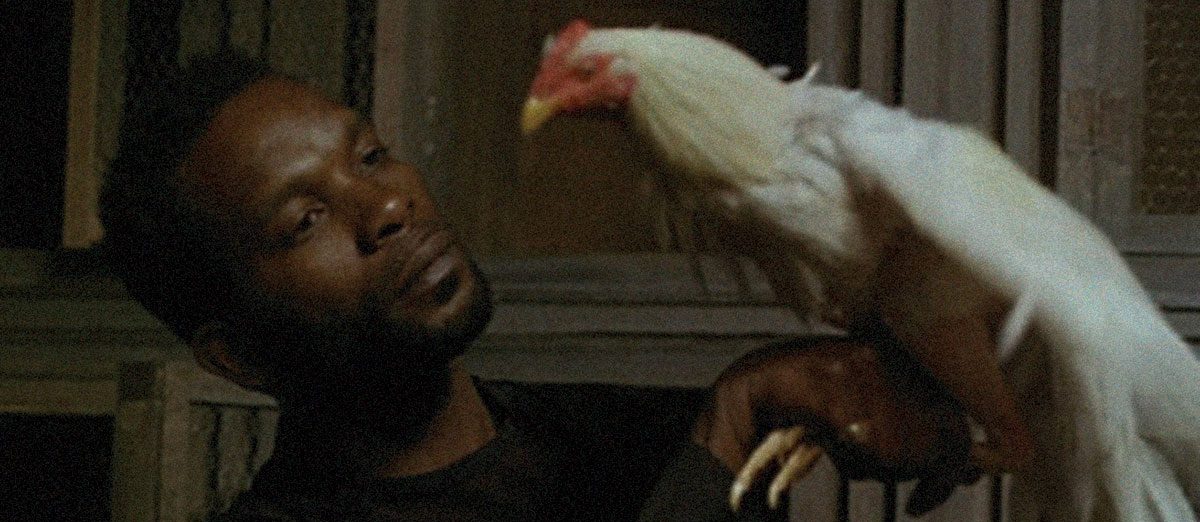
The following notes on No Fear, No Die were written by Ethan Robinson, PhD student in the Department of Communication Arts at UW Madison. Recently restored on DCP, No Fear, No Die will screen on Sunday, September 21, as the first of this season’s four selections at the Chazen Museum of Art. The screening is presented in conjunction with caribbean matters: assemblage and sculpture by pablo delano, an exhibition on view August 11-December 14 at the Chazen. No Fear, No Die begins at 2 p.m. in the Chazen’s auditorium, 750 University Avenue. Admission is free!
By Ethan Robinson
The second feature film from French filmmaker Claire Denis, No Fear, No Die (1990) follows two immigrant men, Dah (Isaach De Bankolé) from Benin and Jocelyn (Alex Descas) from the French Antilles, who scrape out a living through illegal cockfights in a restaurant basement on the outskirts of Paris. Dah and Jocelyn coach their rooster – nicknamed “S’en fout la mort,” which roughly translates to “No Fear, No Die” – under escalating pressure from the domineering organizer of the illegal business. The film premiered in competition at the 47th Venice International Film Festival, where editor Dominique Auvray was awarded a Silver Osella for her work on the film. Newly restored in 4K, the film emerges as a key text – often underseen and ripe for rediscovery – in the lauded oeuvre of its director.
Denis (Beau Travail, 35 Shots of Rum) spent her childhood as a young white woman in colonial West Africa, later relocating to France for polio treatment. This formative view of colonialism – as well as her later discomfort in mainland France – have inspired much of her award-winning work, including her semi-autobiographical drama Chocolat (1988) and the Isabelle Huppert-led White Material (2009). No Fear No Die fits snugly into this tradition. The film’s leading duo are transplants in France, trying to fit into a society that rejects them. Dah and Jocely are valued for their ability to entertain, to bring the all-consuming excitement of cockfighting from the Caribbean to mainland France. The respect of their peers is contingent on this service, and any inconvenience to it will reveal the nation’s true feelings about foreigners. In this way, the legacy of colonialism emerges as the film’s central thematic concern.
Beyond her own experiences, Denis’ inspiration for No Fear No Die arose from the influential writings of the political philosopher and activist Frantz Fanon. Fanon was born in the West Indies but later moved to France where he earned a medical degree with a specialization in psychiatry. In his first book Black Skin White Masks (1952), Fanon explored the legacy of colonization on the psyche of Black French civilians. He argues that the white French majority’s disapproving sentiment toward Black citizens prevented them from ever fully assimilating into white society and, further, into full personhood. In his belief, even when Black French citizens spoke French, obtained an education, and followed social customs associated with white people, they would still never be regarded as truly French. “I understood something in Fanon’s book that touched me immensely,” Denis acknowledged in an interview, “Fanon describes a special type of neurosis – colonized people feeling psychologically defeated even though they are physically free to determine their future.” The film showcases the continued reality of Fanon’s theory in the contemporary moment of the 1990s, nearly 40 years after the publication of his tome.
To realize her vision for No Fear No Die, Denis sought famed South African musician and activist Abdullah Ibrahim to compose the film’s musical score. Ibrahim grew up in South Africa, but he also spent much of his adult life in Europe and America during South Africa’s anti-apartheid movement of the 1960s. His music style reflects his multicultural experiences, ranging from traditional African songs to gospel, Ragas, modern jazz, and other Western styles. Ibrahim’s multicultural approach to music, in addition to the film’s use of rap and Bob Marley’s Buffalo Soldier, paints a vivid soundscape of the far-reaching African diaspora that underlines the film’s struggle with postcolonial identity. Beyond Ibrahim’s score, these diasporic experiences influenced the film’s casting as well. Lead actor Isaach de Bankolé grew up on the Ivory Coast before moving to France in 1975, a shift that, much like the various backgrounds of Denis, Fanon, and Ibrahim, no doubt contributed to his central turn as Dah.
As scholar Judith Mayne noted in her book on Denis, No Fear, No Die is a film that has often been overlooked in the filmmaker’s corpus, arguing that it “has received far less critical attention than any of Denis’s other films.” Thanks to its recent restoration, that scant body of literature is slowly expanding. In a recent essay, New Yorker critic Richard Brody praised the film for its director’s “copious and nuanced observations” and “aesthetic sensibility,” describing No Fear as “Denis’s first masterwork,” an achievement that would “set the tone for her best work to come.” With her ensemble cast and wide-ranging crew of African creators, Denis brings the feelings of this diasporic existence, in all its manifold complexities, to a global audience.